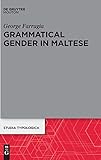Grammatical Gender in Maltese / George Farrugia.
Material type: TextSeries: Studia Typologica [STTYP] : Beihefte / Supplements STUF - Sprachtypologie und Universalienforschung / Language Typology and Universals ; 23Publisher: Berlin ; Boston : De Gruyter Mouton, [2018]Copyright date: ©2018Description: 1 online resource (XVII, 301 p.)Content type:
TextSeries: Studia Typologica [STTYP] : Beihefte / Supplements STUF - Sprachtypologie und Universalienforschung / Language Typology and Universals ; 23Publisher: Berlin ; Boston : De Gruyter Mouton, [2018]Copyright date: ©2018Description: 1 online resource (XVII, 301 p.)Content type: - 9783110603941
- 9783110609721
- 9783110612400
- 492.7955 23/ger
- online - DeGruyter
- Issued also in print.
| Item type | Current library | Call number | URL | Status | Notes | Barcode | |
|---|---|---|---|---|---|---|---|
 eBook
eBook
|
Biblioteca "Angelicum" Pont. Univ. S.Tommaso d'Aquino Nuvola online | online - DeGruyter (Browse shelf(Opens below)) | Online access | Not for loan (Accesso limitato) | Accesso per gli utenti autorizzati / Access for authorized users | (dgr)9783110612400 |
Browsing Biblioteca "Angelicum" Pont. Univ. S.Tommaso d'Aquino shelves, Shelving location: Nuvola online Close shelf browser (Hides shelf browser)

|

|

|

|

|

|

|
||
| online - DeGruyter Menschennatur in Zeiten des Umbruchs : Das Ideal des politischen Arztes in der Frühen Neuzeit / | online - DeGruyter Der Generationenroman / | online - DeGruyter Verkleinerung : Epistemologie und Literaturgeschichte kleiner Formen / | online - DeGruyter Grammatical Gender in Maltese / | online - DeGruyter Book XIII of Ovid’s ›Metamorphoses‹ : A Textual Commentary / | online - DeGruyter Antike Erzähl- und Deutungsmuster : Zwischen Exemplarität und Transformation / | online - DeGruyter Herodotus and the topography of Xerxes' invasion : Place and memory in Greece and Anatolia / |
Frontmatter -- Preface and Acknowledgments -- Contents -- List of Abbreviations -- List of Figures -- List of Tables -- 1. Introduction -- 2. What is grammatical gender? -- 3. Nominal classification -- 4. Grammatical gender in Maltese according to descriptive grammars and dictionaries -- 5. Grammatical gender in Maltese according to native speakers – the form of the noun -- 6. The conceptual underpinnings of gender assignment -- 7. Conclusions -- References -- Appendix I -- Appendix II -- Glossary -- Index of Authors -- Index of Languages -- Index of Subjects
restricted access online access with authorization star
http://purl.org/coar/access_right/c_16ec
Is grammatical gender merely stored as a syntactic property of nouns, or is it computed according to a noun’s semantic, morphological and phonological properties every time it is required?In many languages, gender appears to resist systematic treatment and can even cause problems for non-native learners. Native speakers of these languages appear to have no difficulty in assigning the correct grammatical gender to thousands of nouns in their language. Being an offshoot of Arabic, Maltese inherited a system comprising two gender categories, masculine and feminine. Numerous nouns were introduced in Maltese through contact with Sicilian and subsequently with Italian, two languages that also have a masculine/feminine-based gender system. However, the more recent contact, with English, seems to have complicated matters.This work investigates how grammatical gender functions in Maltese, how native speakers apply different criteria to classify nouns, and how this choice is reflected in syntactic agreement. It also takes into consideration the wider psycholinguistic context that influences the choice of category, and provides valuable data for theories that seek to explain the linguistic categorization of nouns in various languages.
Issued also in print.
Mode of access: Internet via World Wide Web.
In English.
Description based on online resource; title from PDF title page (publisher's Web site, viewed 25. Jun 2024)


